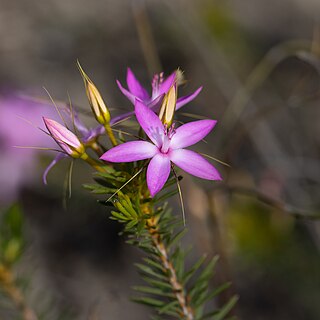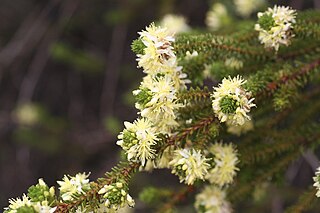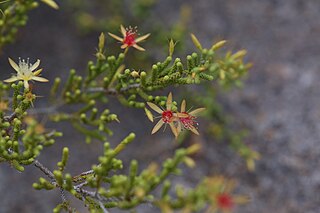
Calytrix depressa is a species of flowering plant in the myrtle family Myrtaceae and is endemic to the south-west of Western Australia. It is a glabrous shrub with linear to lance-shaped leaves and mauve to violet or yellow flowers with 35 to 75 stamens in several rows.
Calytrix amethystina is a species of flowering plant in the myrtle family Myrtaceae and is endemic to inland areas of Western Australia. It is a glabrous shrub with egg-shaped to oblong or more or less round leaves and clusters of purple to violet flowers with about 35 to 80 white stamens in several rows.

Calytrix asperula, commonly known as brush starflower, is a species of flowering plant in the myrtle family Myrtaceae and is endemic to the south of Western Australia. It is a mostly glabrous shrub with linear to narrowly elliptic leaves and cream-coloured to yellow flowers with 40 to 60 yellow stamens in several rows.

Calytrix brevifolia is a species of flowering plant in the myrtle family Myrtaceae and is endemic to the west of Western Australia. It is a glabrous shrub with egg-shaped, linear, elliptic or more or less round leaves and clusters of pink to magenta flowers with about 40 to 90 yellow stamens in 4 rows.
Calytrix breviseta is a species of flowering plant in the myrtle family Myrtaceae and is endemic to the south-west of Western Australia. It is a more or less glabrous shrub with egg-shaped, elliptic, lanceolate, oblong or linear leaves and clusters of purple flowers with about 25 to 65 white stamens in several rows, becoming reddish-purple as they age.

Calytrix carinata is a species of flowering plant in the myrtle family Myrtaceae and is endemic to northern Australia. It is a more or less glabrous shrub with egg-shaped, elliptic, linear or lanceolate leaves and clusters of pink, pinkish purple, or reddish flowers with about 30 to 50 pink and yellowish white stamens in two rows.

Calytrix decandra, commonly known as pink starflower, is a species of flowering plant in the myrtle family Myrtaceae and is endemic to the south of Western Australia. It is a semi-prostrate, glabrous shrub with linear to narrowly elliptic leaves and pink, mauve or magenta flowers with usually 10 stamens in a single row.

Calytrix desolata is a species of flowering plant in the myrtle family Myrtaceae and is endemic to the western regions of Western Australia. It is a glabrous shrub with linear oblong or lance-shaped leaves with the narrower end towards the base, and pink to purple flowers with about 30 to 60 stamens in several rows.
Calytrix divergens is a species of flowering plant in the myrtle family Myrtaceae and is endemic to inland areas of Western Australia. It is a mostly glabrous shrub with egg-shaped, lance-shaped or oblong leaves, and yellow flowers with about 40 to 80 stamens in several rows.

Calytrix drummondii is a species of flowering plant in the myrtle family Myrtaceae and is endemic to the Geraldton Sandplains bioregion of Western Australia. It is a glabrous shrub with linear leaves, and yellow flowers with about 55 to 85 yellow stamens in several rows.

Calytrix duplistipulata is a species of flowering plant in the myrtle family Myrtaceae and is endemic to inland areas of Western Australia. It is a glabrous shrub with elliptic to egg-shaped or oblong leaves, and pink to purple flowers with about 9 to 16 stamens in a single row.
Calytrix ecalycata is a species of flowering plant in the myrtle family Myrtaceae and is endemic to the south-west of Western Australia. It is a slender, erect shrub with linear to narrowly elliptic leaves, and yellow flowers with 35 to 50 stamens in several rows.
Calytrix erosipetala is a species of flowering plant in the myrtle family Myrtaceae and is endemic to inland areas of Western Australia. It is a glabrous shrub with spreading lance-shaped to egg-shaped or linear leaves, and white to pink flowers with about 18 to 24 stamens in a single row.

Calytrix flavescens, commonly known as summer starflower, is a species of flowering plant in the myrtle family Myrtaceae and is endemic to the south-west of Western Australia. It is a shrub with linear to narrowly elliptic leaves, and yellow flowers with about 35 to 60 stamens in several rows.
Calytrix formosa is a species of flowering plant in the myrtle family Myrtaceae and is endemic to the west of Western Australia. It is a glabrous shrub with erect, elliptic, broadly elliptic or oblong leaves, and pink flowers with about 90 to 105 stamens in multiple rows.

Calytrix fraseri, commonly known as pink summer calytrix or pink summer starflower, is a species of flowering plant in the myrtle family Myrtaceae and is endemic to the south-west of Western Australia. It is a shrub with oblong, linear or elliptic leaves with the narrower end towards the base, and pink, cerise or pinkish purple flowers with about 35 to 55 stamens in several rows.

Calytrix glutinosa is a species of flowering plant in the myrtle family Myrtaceae and is endemic to the south-west of Western Australia. It is a more or less glabrous shrub with linear leaves and clusters of pink to mauve flowers with about 10 to 20 white stamens in one or two rows, becoming reddish-purple as they age.

Calytrix decussata is a species of flowering plant in the myrtle family Myrtaceae and is endemic to the Northern Territory. It is a shrub with linear to lance-shaped leaves and pinkish-mauve flowers arranged singly or in scatter groups with about 45 to 50 white stamens that become reddish-purple as the flower ages.

Calytrix faucicola is a species of flowering plant in the myrtle family Myrtaceae and is endemic to the Northern Territory. It is a mostly glabrous shrub with spreading egg-shaped or linear leaves, and pale yellow flowers with about 35 to 45 stamens in several rows.

Calytrix glaberrima, commonly known as smooth fringe-myrtle, is a species of flowering plant in the myrtle family Myrtaceae and is endemic to the south of South Australia. It is a woody, glabrous shrub with elliptic, linear or egg-shaped leaves and clusters of white to pink flowers with 20 to 30 white stamens in a single row.













